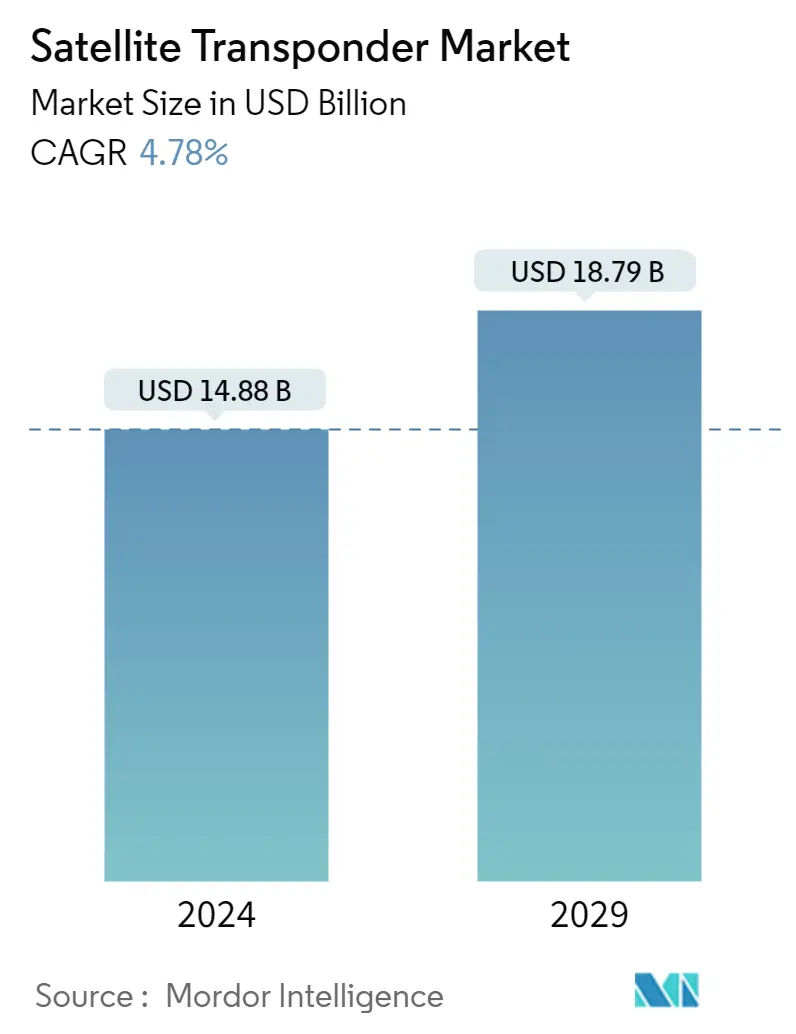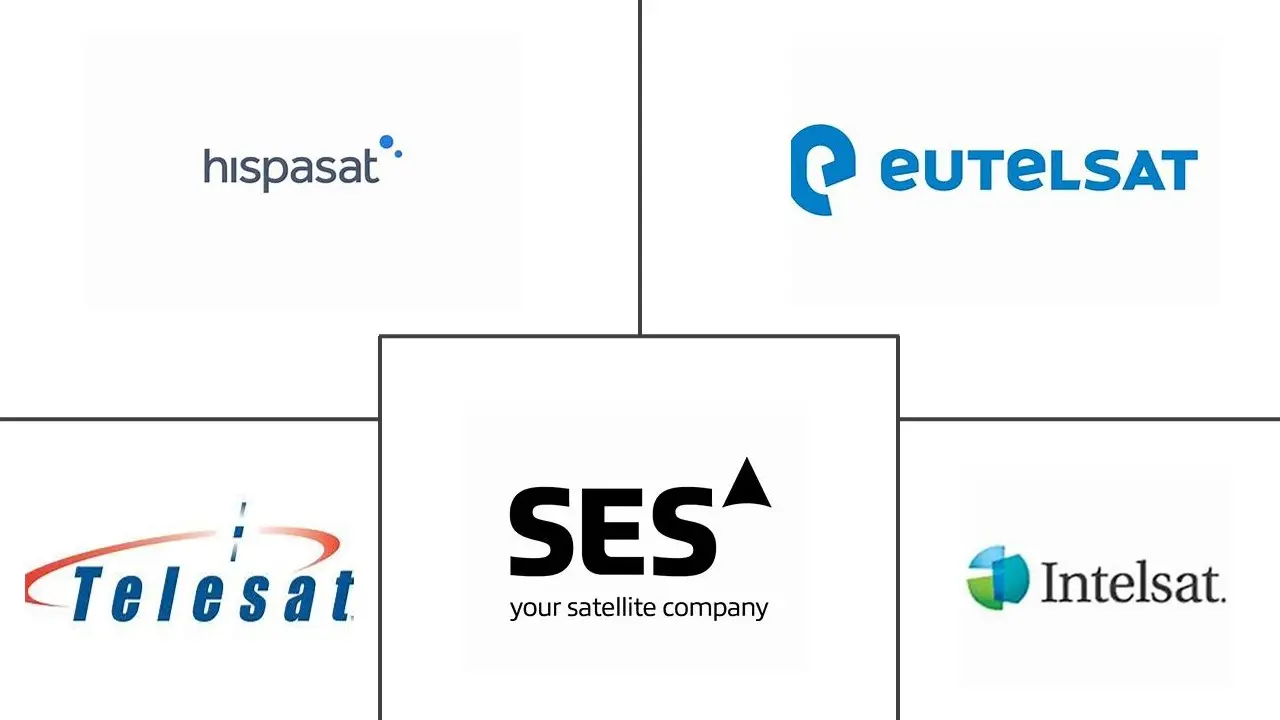Market Size of Satellite Transponder Industry

| Study Period | 2019 - 2029 |
| Market Size (2024) | USD 14.88 Billion |
| Market Size (2029) | USD 18.79 Billion |
| CAGR (2024 - 2029) | 4.78 % |
| Fastest Growing Market | Asia Pacific |
| Largest Market | North America |
| Market Concentration | Medium |
Major Players
*Disclaimer: Major Players sorted in no particular order |
Satellite Transponder Market Analysis
The Satellite Transponder Market size is estimated at USD 14.88 billion in 2024, and is expected to reach USD 18.79 billion by 2029, growing at a CAGR of 4.78% during the forecast period (2024-2029).
Satellite transponders are minor chip-size circuits integrated into satellites to transmit the uplink data or information to the downlink and vice-versa. The development of new cost-effective satellite technologies, growing demand for telecommunication services, and availability of efficient and practical technological solutions coupled with growth in demand for Ku-band and Ka-band are likely to drive the satellite transponder market over the forecast period.
- With the rise of internet penetration worldwide, broadband connectivity has become a critical source of information. This, coupled with the growing demand for high-speed internet, will significantly drive the demand for satellite transponders in the coming years. For instance, according to the ITU data, internet users worldwide increased from 3,729 million in 2018 to 4,901 million in 2021.
- The increasing demand for C band (which provides lower transmission power over vast geographic areas and typically requires larger ground equipment for reception) and Ku band (which offers higher transmission power over smaller geographic regions and can be received with smaller ground equipment) transponder by the commercial sector worldwide, is expected to augment the growth of the satellite transponders market in the future.
- In addition, satellite operators are now developing applications over the Ku-band and Ka-band frequency bands, which may facilitate increased transmission speeds and important information transfer with the usage of small ground equipment. Ka-band and Ku-band bandwidth/transponders' leasing is expected to account for the majority of the growth in the satellite transponder market. Of this leasing, Ka-band is expected to witness the highest growth rate in the forecast period.
- Moreover, growth in Ku-band service demand is expected to generate significant traction for satellite transponders over the forecast period. Ku-band satellite communication systems are increasingly being deployed for various emergency communications during natural disasters and for satellite news gathering (SNG) by TV broadcasters in remote or rural areas where fiber and cable networks are unavailable.
- Further, with the emergence of the Internet of Things (IoT) and Industry 4.0 across the globe, broadband connectivity plays a crucial role in providing information to individuals. The telecom industry players are looking to lease satellite transponders to deliver broadband facilities to isolated places as well as across the globe. Various market vendors, such as Singtel, are capitalizing on the opportunity and offering extensive coverage, myriad transponder capacity bandwidths, and flexible satellite transponder lease services to fulfill business needs.
- During the COVID-19 pandemic, satellite communications enabled access to telemedicine to diagnose diseases or treat individuals who were quarantined, reducing the need for face-to-face interaction between healthcare personnel and patients. The applications of satellite transponders primarily supported such instances, thus positively impacting the market's growth. However, the impact of the COVID-19 pandemic on the global economy resulted in some satellite communication projects being postponed, delayed, and canceled, significantly impacting the satellite transponder leasing business.
Satellite Transponder Industry Segmentation
A wireless communications device is usually connected to a satellite. A transponder receives and transmits radio signals at a designated frequency spectrum. After receiving the signal, a transponder will at the same time broadcast the signal at a distinct frequency. The term is an incorporation of the words transmitter and responder. Transponders are used in satellite communications and location, identification, and navigation systems/methods.
The satellite transponder market is segmented by application (commercial communications, government communications, navigation, remote sensing, research and development), service (leasing, maintenance & support), and geography(North America, Europe, Asia-Pacific, Latin America, Middle East & Africa). All the above segments of this market are valued in (USD).
| By Application | |
| Commercial Communications | |
| Government Communications | |
| Navigation | |
| Remote Sensing | |
| Other Applications |
| By Service | |
| Leasing | |
| Maintenance and Support | |
| Other Services |
| Geography | |
| North America | |
| Europe | |
| Asia-Pacific | |
| Latin America | |
| Middle East & Africa |
Satellite Transponder Market Size Summary
The satellite transponder market is poised for significant growth, driven by the increasing demand for telecommunication services and the development of cost-effective satellite technologies. Satellite transponders, essential for transmitting data between uplink and downlink, are witnessing heightened demand due to the surge in internet penetration and the need for high-speed broadband connectivity. The market is expected to benefit from the growing adoption of Ku-band and Ka-band frequency bands, which offer enhanced transmission speeds and efficiency. These advancements are particularly relevant for applications in emergency communications, satellite news gathering, and the expanding Internet of Things (IoT) landscape. The COVID-19 pandemic further underscored the importance of satellite communications, facilitating telemedicine and remote connectivity, although it also led to project delays and cancellations.
The market is characterized by a semi-consolidated structure with major players like SES S.A., Arabsat, and Intelsat S.A. dominating the landscape. The leasing of satellite transponders is gaining traction, driven by the need for reliable, bandwidth-intensive applications and the growing subscriber base of OTT platforms. North America is expected to maintain its dominance in the market, supported by technological advancements and a robust demand for secure satellite-based communication. The region's focus on Ka-band transponders for 4K-UHD and OTT TV services highlights the ongoing evolution in satellite communication capabilities. Strategic partnerships and innovations in satellite technology, such as those by SpaceX and SAIC, are further propelling market growth, with an emphasis on advanced commercial imaging and defense applications.
Satellite Transponder Market Size - Table of Contents
-
1. MARKET INSIGHTS
-
1.1 Market Overview
-
1.2 Industry Attractiveness - Porter's Five Forces Analysis
-
1.2.1 Bargaining Power of Buyers/Consumers
-
1.2.2 Bargaining Power of Suppliers
-
1.2.3 Threat of New Entrants
-
1.2.4 Threat of Substitute Products
-
1.2.5 Intensity of Competitive Rivalry
-
-
1.3 Industry Value Chain Analysis
-
1.4 Assessment of the Impact of COVID-19 on the Market
-
-
2. MARKET SEGMENTATION
-
2.1 By Application
-
2.1.1 Commercial Communications
-
2.1.2 Government Communications
-
2.1.3 Navigation
-
2.1.4 Remote Sensing
-
2.1.5 Other Applications
-
-
2.2 By Service
-
2.2.1 Leasing
-
2.2.2 Maintenance and Support
-
2.2.3 Other Services
-
-
2.3 Geography
-
2.3.1 North America
-
2.3.2 Europe
-
2.3.3 Asia-Pacific
-
2.3.4 Latin America
-
2.3.5 Middle East & Africa
-
-
Satellite Transponder Market Size FAQs
How big is the Satellite Transponder Market?
The Satellite Transponder Market size is expected to reach USD 14.88 billion in 2024 and grow at a CAGR of 4.78% to reach USD 18.79 billion by 2029.
What is the current Satellite Transponder Market size?
In 2024, the Satellite Transponder Market size is expected to reach USD 14.88 billion.

